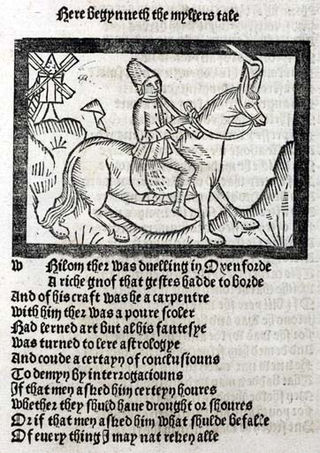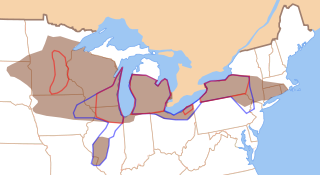Related Research Articles
English orthography is the writing system used to represent spoken English, allowing readers to connect the graphemes to sound and to meaning. It includes English's norms of spelling, hyphenation, capitalisation, word breaks, emphasis, and punctuation.

The Great Vowel Shift was a series of changes in the pronunciation of the English language that took place primarily between 1400 and 1700, beginning in southern England and today having influenced effectively all dialects of English. Through this vowel shift, the pronunciation of all Middle English long vowels was changed. Some consonant sounds also changed, particularly those that became silent; the term Great Vowel Shift is sometimes used to include these consonantal changes.
A rhyme is a repetition of similar sounds in the final stressed syllables and any following syllables of two or more words. Most often, this kind of perfect rhyming is consciously used for a musical or aesthetic effect in the final position of lines within poems or songs. More broadly, a rhyme may also variously refer to other types of similar sounds near the ends of two or more words. Furthermore, the word rhyme has come to be sometimes used as a shorthand term for any brief poem, such as a nursery rhyme or Balliol rhyme.

Middle English is a form of the English language that was spoken after the Norman Conquest of 1066, until the late 15th century. The English language underwent distinct variations and developments following the Old English period. Scholarly opinion varies, but Oxford University Press specifies the period when Middle English was spoken as being from 1100 to 1500. This stage of the development of the English language roughly followed the High to the Late Middle Ages.
In linguistics, an elision or deletion is the omission of one or more sounds in a word or phrase. However, these terms are also used to refer more narrowly to cases where two words are run together by the omission of a final sound. An example is the elision of word-final /t/ in English if it is preceded and followed by a consonant: "first light" is often pronounced “firs’ light” Many other terms are used to refer to specific cases where sounds are omitted.

Œ is a Latin alphabet grapheme, a ligature of o and e. In medieval and early modern Latin, it was used in borrowings from Greek that originally contained the diphthong οι, and in a few non-Greek words. These usages continue in English and French. In French, the words that were borrowed from Latin and contained the Latin diphthong written as œ now generally have é or è; but œ is still used in some non-learned French words, representing mid-front rounded vowel-sounds, such as œil ("eye") and sœur ("sister").

Middle Chinese or the Qieyun system (QYS) is the historical variety of Chinese recorded in the Qieyun, a rime dictionary first published in 601 and followed by several revised and expanded editions. The Swedish linguist Bernard Karlgren believed that the dictionary recorded a speech standard of the capital Chang'an of the Sui and Tang dynasties. However, based on the preface of the Qieyun, most scholars now believe that it records a compromise between northern and southern reading and poetic traditions from the late Northern and Southern dynasties period. This composite system contains important information for the reconstruction of the preceding system of Old Chinese phonology.
The phonology of the open back vowels of the English language has undergone changes both overall and with regional variations, through Old and Middle English to the present. The sounds heard in modern English were significantly influenced by the Great Vowel Shift, as well as more recent developments in some dialects such as the cot–caught merger.
Historical Chinese phonology deals with reconstructing the sounds of Chinese from the past. As Chinese is written with logographic characters, not alphabetic or syllabary, the methods employed in Historical Chinese phonology differ considerably from those employed in, for example, Indo-European linguistics; reconstruction is more difficult because, unlike Indo-European languages, no phonetic spellings were used.
English phonology is the system of speech sounds used in spoken English. Like many other languages, English has wide variation in pronunciation, both historically and from dialect to dialect. In general, however, the regional dialects of English share a largely similar phonological system. Among other things, most dialects have vowel reduction in unstressed syllables and a complex set of phonological features that distinguish fortis and lenis consonants.
Early Modern English or Early New English (ENE) is the stage of the English language from the beginning of the Tudor period to the English Interregnum and Restoration, or from the transition from Middle English, in the late 15th century, to the transition to Modern English, in the mid-to-late 17th century.
The close and mid-height front vowels of English have undergone a variety of changes over time and often vary by dialect.
There are a variety of pronunciations in modern English and in historical forms of the language for words spelled with the letter ⟨a⟩. Most of these go back to the low vowel of earlier Middle English, which later developed both long and short forms. The sound of the long vowel was altered in the Great Vowel Shift, but later a new long A developed which was not subject to the shift. These processes have produced the main four pronunciations of ⟨a⟩ in present-day English: those found in the words trap, face, father and square. Separate developments have produced additional pronunciations in words like wash, talk and comma.
In English, many vowel shifts affect only vowels followed by in rhotic dialects, or vowels that were historically followed by that has been elided in non-rhotic dialects. Most of them involve the merging of vowel distinctions and so fewer vowel phonemes occur before than in other positions of a word.
Ancient Greek phonology is the reconstructed phonology or pronunciation of Ancient Greek. This article mostly deals with the pronunciation of the standard Attic dialect of the fifth century BC, used by Plato and other Classical Greek writers, and touches on other dialects spoken at the same time or earlier. The pronunciation of Ancient Greek is not known from direct observation, but determined from other types of evidence. Some details regarding the pronunciation of Attic Greek and other Ancient Greek dialects are unknown, but it is generally agreed that Attic Greek had certain features not present in English or Modern Greek, such as a three-way distinction between voiced, voiceless, and aspirated stops ; a distinction between single and double consonants and short and long vowels in most positions in a word; and a word accent that involved pitch.
Like many other languages, English has wide variation in pronunciation, both historically and from dialect to dialect. In general, however, the regional dialects of English share a largely similar phonological system. Among other things, most dialects have vowel reduction in unstressed syllables and a complex set of phonological features that distinguish fortis and lenis consonants.
In the history of English phonology, there have been many diachronic sound changes affecting vowels, especially involving phonemic splits and mergers.
This article describes those aspects of the phonological history of the English language which concern consonants.

Northern American English or Northern U.S. English is a class of historically related American English dialects, spoken by predominantly white Americans, in much of the Great Lakes region and some of the Northeast region within the United States. The North as a super-dialect region is best documented by the 2006 Atlas of North American English (ANAE) in the greater metropolitan areas of Connecticut, Western Massachusetts, Western and Central New York, Northwestern New Jersey, Northeastern Pennsylvania, Northern Ohio, Northern Indiana, Northern Illinois, Northeastern Nebraska, and Eastern South Dakota, plus among certain demographics or areas within Michigan, Wisconsin, Minnesota, Vermont, and New York's Hudson Valley. The ANAE describes that the North, at its core, consists of the Inland Northern dialect and Southwestern New England dialect.
Standard Cantonese pronunciation is that of Guangzhou, also known as Canton, capital of Guangdong Province. Hong Kong Cantonese is related to Guangzhou dialect, and they diverge only slightly. Yue dialects in other parts of Guangdong and Guangxi provinces like Taishanese, may be considered divergent to a greater degree.
References
- ↑ "Rhyme". Columbia Electronic Encyclopedia (6th (2011): 1. MAS Ultra – School ed.). 2012. p. 23.
- ↑ "Tea". Online Etymological Dictionary. Retrieved 19 August 2020.
- ↑ "In Memory of W. B. Yeats read by W. H. Auden". June 2013. Retrieved 19 August 2020– via Vimeo.